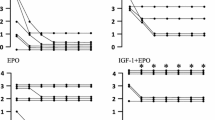Purpose:
To test whether insulin-like growth factor-1 (IGF-1) and amifostine modulate the reirradiation tolerance of rat cervical spinal cord. Initial experiments by the authors’ group suggested that administration of each agent alone significantly increased the median latent time to radiation myelopathy (RM) in previously unirradiated animals but did not change the dose-response relationship. Because of different modes of action, a follow-up study was undertaken to test the combined treatment.
Material and Methods:
The cervical spinal cord of 51 adult Fisher F-344 rats received a single fraction of 16 Gy, which corresponds to approximately 75% of the median paresis dose (ED50), followed 5 months later by a second radiation dose, which ranged from 17 to 21 Gy. The study animals received a single intrathecal injection of 0.3 mg amifostine into the cisterna magna 30-60 min before reirradiation plus three subcutaneous doses of IGF-1 (700 µg) starting from 24 h before to 24 h after reirradiation. Control animals received saline injections via the same routes. Animals were followed until RM developed or until 12 months from reirradiation. Histopathologic examinations were performed post mortem.
Results:
No animals showed any neurologic abnormalities before reirradiation. RM occurred in controls versus treated rats after a mean latency of 218 versus 314 days (19 Gy; p = 0.11) and 104 versus 186 days (21 Gy; p = 0.002) from second dose (Figure 1). ED50 was 18.2 versus 19.4 Gy (p = 0.15; Figure 2). Treatment with IGF-1 and amifostine did not significantly influence the rates of tumor induction or intercurrent death.
Conclusion:
IGF-1 and amifostine significantly reduced RM rates after 21 Gy. The shift of the dose-response curve suggests an increase of the ED50 for single-dose treatment by approximately 7%. Thus, brief therapeutic intervention might slightly decrease radiation-induced neurotoxicity in a retreatment situation.
Ziel:
Untersuchung der Fähigkeit von insulin-like growth factor-1 (IGF-1) und Amifostin, die Zweitbestrahlungstoleranz des Rückenmarks von Ratten zu beeinflussen. Erste eigene Experimente ergaben, dass die Applikation jeder Einzelsubstanz bei noch nicht vorbestrahlten Tieren die mediane Latenzzeit bis zum Auftreten einer Strahlenmyelopathie signifikant verlängerte, ohne jedoch die Dosis-Wirkungs-Beziehung zu verändern. Da die Substanzen unterschiedliche Wirkmechanismen aufweisen, wurde die Kombination der beiden Behandlungen in einem Folgeexperiment getestet.
Material und Methodik:
Das zervikale Rückenmark von 51 erwachsenen Fisher-F-344-Ratten erhielt eine Einzeitdosis von 16 Gy, die ca. 75% der medianen Toleranzdosis (ED50) entspricht. Nach 5 Monaten wurde eine zweite Bestrahlungsdosis von 17-21 Gy gegeben. Ein Teil der Tiere erhielt 30-60 min vor der Zweitbestrahlung eine intrathekale Injektion von 0,3 mg Amifostin in die Cisterna magna. Zusätzlich wurden drei subkutane Injektionen von IGF-1 (jeweils 700 µg) gegeben, die erste 24 h vor, die letzte 24 h nach der Zweitbestrahlung. Die Kontrolltiere erhielten Kochsalzinjektionen über die gleichen Zugangswege. Alle Tiere wurden bis zur Entwicklung einer Strahlenmyelopathie oder für maximal 12 Monate nach der Zweitbestrahlung nachbeobachtet. Post mortem erfolgten histopathologische Untersuchungen.
Ergebnisse:
Keines der Tiere entwickelte neurologische Auffälligkeiten vor der Zweitbestrahlung. Eine Strahlenmyelopathie trat nach einer mittleren Latenzzeit von 218 versus 314 Tagen (Kontrollen vs. IGF-1/Amifostin, 19 Gy; p = 0,11) und 104 versus 186 Tagen (21 Gy; p = 0,002) nach der Zweitbestrahlung auf (Abbildung 1). Die ED50 betrug 18,2 versus 19,4 Gy (p = 0,15; Abbildung 2). Die Gabe von IGF-1 und Amifostin hatte keinen signifikanten Einfluss auf die Entstehung strahleninduzierter Tumoren bzw. die Rate interkurrenter Todesfälle.
Schlussfolgerung:
IGF-1 und Amifostin führten zu einer signifikanten Reduktion der Strahlenmyelopathie-Rate nach 21 Gy. Die Verschiebung der Dosis-Effekt-Kurve spricht für einen Anstieg der ED50 für Einzeitbestrahlungen um ca. 7%. Somit kann eine kurze Therapie die aus einer Zweitbestrahlung resultierende Neurotoxizität offensichtlich etwas reduzieren.
Similar content being viewed by others
Author information
Authors and Affiliations
Corresponding author
Rights and permissions
About this article
Cite this article
Nieder, C., Price, R.E., Rivera, B. et al. Effects of Insulin-Like Growth Factor-1 (IGF-1) and Amifostine in Spinal Cord Reirradiation. Strahlenther Onkol 181, 691–695 (2005). https://doi.org/10.1007/s00066-005-1464-x
Received:
Revised:
Issue Date:
DOI: https://doi.org/10.1007/s00066-005-1464-x
Key Words:
- Radiation myelopathy
- Spinal cord radiotherapy
- Reirradiation
- Growth factors
- Insulin-like growth factor-1
- Amifostine




